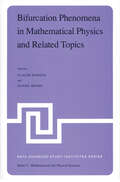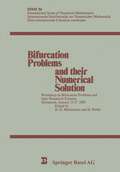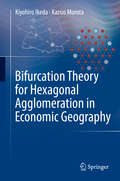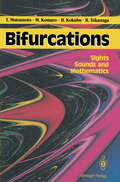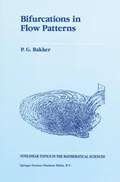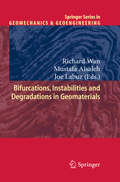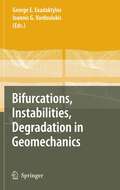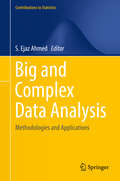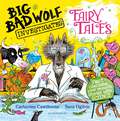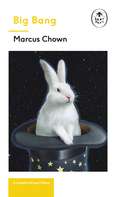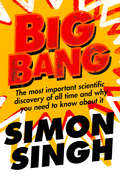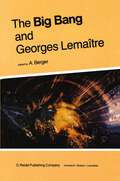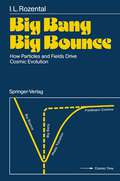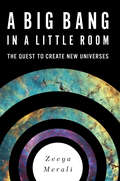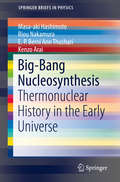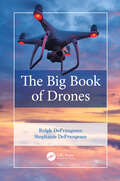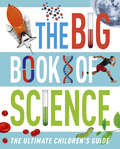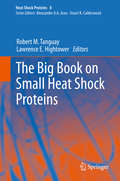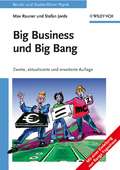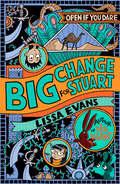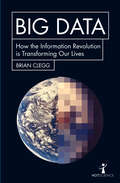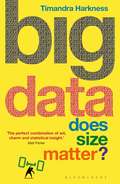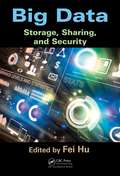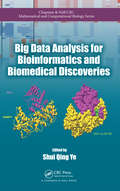- Table View
- List View
Bifurcation Phenomena in Mathematical Physics and Related Topics: Proceedings of the NATO Advanced Study Institute held at Cargèse, Corsica, France, June 24–July 7, 1979 (Nato Science Series C: #54)
by C. Bardos D. BessisOne of the main ideas in organizing the Summer Institute of Cargese on "Bifurcation Phenomena in Mathematical Physics and Related Topics" was to bring together Physicists and Mathematicians working on the properties arising from the non linearity of the phenomena and of the models that are used for their description. Among these properties the existence of bifurcations is one of the most interesting, and we had a general survey of the mathematical tools used in this field. This survey was done by M. Crandall and P. Rabinowitz and the notes enclosed in these proceedings were written by E. Buzano a]ld C. Canuto. Another mathematical approach, using Morse Theory was given by J. Smoller reporting on a joint work with C. Conley. An example of a direct application was given by M. Ghil. For physicists the theory of bifurcation is closely related to critical phenomena and this was explained in a series of talks given by J.P. Eckmann, G. Baker and M. Fisher. Some related ideas can be found in the talk given by T. T. Wu , on a joint work with Barry Mc Coy on quantum field theory. The description of these phenomena leads to the use of Pade approximants (it is explained for instance in the lectures of J. Nuttall) and then to some problems in drop hot moment problems. (cf. the lecture of D. Bessis).
Bifurcation Problems and their Numerical Solution: Workshop on Bifurcation Problems and their Numerical Solution Dortmund, January 15–17, 1980 (International Series of Numerical Mathematics #54)
by H. D. Mittelmann H. WeberBifurcation Theory for Hexagonal Agglomeration in Economic Geography
by Kiyohiro Ikeda Kazuo MurotaThis book contributes to an understanding of how bifurcation theory adapts to the analysis of economic geography. It is easily accessible not only to mathematicians and economists, but also to upper-level undergraduate and graduate students who are interested in nonlinear mathematics. The self-organization of hexagonal agglomeration patterns of industrial regions was first predicted by the central place theory in economic geography based on investigations of southern Germany. The emergence of hexagonal agglomeration in economic geography models was envisaged by Krugman. In this book, after a brief introduction of central place theory and new economic geography, the missing link between them is discovered by elucidating the mechanism of the evolution of bifurcating hexagonal patterns. Pattern formation by such bifurcation is a well-studied topic in nonlinear mathematics, and group-theoretic bifurcation analysis is a well-developed theoretical tool. A finite hexagonal lattice is used to express uniformly distributed places, and the symmetry of this lattice is expressed by a finite group. Several mathematical methodologies indispensable for tackling the present problem are gathered in a self-contained manner. The existence of hexagonal distributions is verified by group-theoretic bifurcation analysis, first by applying the so-called equivariant branching lemma and next by solving the bifurcation equation. This book offers a complete guide for the application of group-theoretic bifurcation analysis to economic agglomeration on the hexagonal lattice.
Bifurcations: Sights, Sounds, and Mathematics
by Takashi Matsumoto Motomasa Komuro Hiroshi Kokubu Ryuji TokunagaBifurcation originally meant "splitting into two parts. " Namely, a system under goes a bifurcation when there is a qualitative change in the behavior of the sys tem. Bifurcation in the context of dynamical systems, where the time evolution of systems are involved, has been the subject of research for many scientists and engineers for the past hundred years simply because bifurcations are interesting. A very good way of understanding bifurcations would be to see them first and study theories second. Another way would be to first comprehend the basic concepts and theories and then see what they look like. In any event, it is best to both observe experiments and understand the theories of bifurcations. This book attempts to provide a general audience with both avenues toward understanding bifurcations. Specifically, (1) A variety of concrete experimental results obtained from electronic circuits are given in Chapter 1. All the circuits are very simple, which is crucial in any experiment. The circuits, however, should not be too simple, otherwise nothing interesting can happen. Albert Einstein once said "as simple as pos sible, but no more" . One of the major reasons for the circuits discussed being simple is due to their piecewise-linear characteristics. Namely, the voltage current relationships are composed of several line segments which are easy to build. Piecewise-linearity also simplifies rigorous analysis in a drastic man ner. (2) The piecewise-linearity of the circuits has far reaching consequences.
Bifurcations in Flow Patterns: Some Applications of the Qualitative Theory of Differential Equations in Fluid Dynamics (Nonlinear Topics in the Mathematical Sciences #2)
by P.G. BakkerThe main idea of the present study is to demonstrate that the qualitative theory of diffe rential equations, when applied to problems in fluid-and gasdynamics, will contribute to the understanding of qualitative aspects of fluid flows, in particular those concerned with geometrical properties of flow fields such as shape and stability of its streamline patterns. It is obvious that insight into the qualitative structure of flow fields is of great importance and appears as an ultimate aim of flow research. Qualitative insight fashions our know ledge and serves as a good guide for further quantitative investigations. Moreover, quali tative information can become very useful, especially when it is applied in close corres pondence with numerical methods, in order to interpret and value numerical results. A qualitative analysis may be crucial for the investigation of the flow in the neighbourhood of singularities where a numerical method is not reliable anymore due to discretisation er rors being unacceptable. Up till now, familiar research methods -frequently based on rigorous analyses, careful nu merical procedures and sophisticated experimental techniques -have increased considera bly our qualitative knowledge of flows, albeit that the information is often obtained indirectly by a process of a careful but cumbersome examination of quantitative data. In the past decade, new methods are under development that yield the qualitative infor mation more directly. These methods, make use of the knowledge available in the qualitative theory of differen tial equations and in the theory of bifurcations.
Bifurcations, Instabilities and Degradations in Geomaterials (Springer Series in Geomechanics and Geoengineering)
by Richard Wan Mustafa Alsaleh Joe LabuzGeomaterials exhibit complex but rich mechanical behaviour with a variety of failure modes ranging from diffuse to localized deformation depending on stress, density, microstructure, and loading conditions. These failure modes are a result of an instability of material and/or geometric nature that can be studied within the framework of bifurcation theory. Degradation is another related phenomenon arising from cyclic loading, ageing, weathering, chemical attack, and capillary effects, among others. The methodology of analyzing the various types of instabilities is crucial in the adequate modelling and safe design of numerous problems in geomechanics.The present volume contains a sampling of enlarged versions of papers presented at the International Workshop on Bifurcation and Degradations in Geomaterials (IWBDG 2008) held in Lake Louise, Alberta, Canada, May 28-31, 2008. These papers capture the state-of-the-art in the specialized field of geomechanics and contemporary approaches to solving the central issue of failure. Some engineering applications are presented in the areas of energy resource extraction and soil-machine interaction.
Bifurcations, Instabilities, Degradation in Geomechanics
by George Exadaktylos Ioannis G. VardoulakisThis is an up-to-date review of developments in the field of bifurcations and instabilities in geomechanics from some of the world’s leading experts. Leading international researchers and practitioners of the topics debate the developments and applications which have occurred over the last few decades. Beside fundamental research findings, applications in geotechnical, petroleum, mining, and bulk materials engineering are emphasised.
Big and Complex Data Analysis: Methodologies and Applications (Contributions to Statistics)
by S. Ejaz AhmedThis volume conveys some of the surprises, puzzles and success stories in high-dimensional and complex data analysis and related fields. Its peer-reviewed contributions showcase recent advances in variable selection, estimation and prediction strategies for a host of useful models, as well as essential new developments in the field.The continued and rapid advancement of modern technology now allows scientists to collect data of increasingly unprecedented size and complexity. Examples include epigenomic data, genomic data, proteomic data, high-resolution image data, high-frequency financial data, functional and longitudinal data, and network data. Simultaneous variable selection and estimation is one of the key statistical problems involved in analyzing such big and complex data. The purpose of this book is to stimulate research and foster interaction between researchers in the area of high-dimensional data analysis. More concretely, its goals are to: 1) highlight and expand the breadth of existing methods in big data and high-dimensional data analysis and their potential for the advancement of both the mathematical and statistical sciences; 2) identify important directions for future research in the theory of regularization methods, in algorithmic development, and in methodologies for different application areas; and 3) facilitate collaboration between theoretical and subject-specific researchers.
Big Bad Wolf Investigates Fairy Tales: Fact-checking your favourite stories with SCIENCE!
by Catherine CawthorneJoin the Big Bad Wolf as he debunks your favourite fairy tales with SCIENCE! Written by the hilarious Catherine Cawthorne and illustrated by award-winning Sara Ogilvie.Did a princess really feel a tiny pea through a mountain of mattresses? And could a pumpkin actually turn into a carriage to carry Cinderella to the ball? Of course not! It's all a load of fairytale NONSENSE! Or is it . . . ? The Big Bad Wolf is on a mission to find the truth behind these tales, and clear his name in the process.Combining STEM topics with classic stories children know and love, this hilarious non-fiction picture book is perfect for inquisitive children always asking big questions!
Big Bang: Discover how the universe began
by Marcus ChownPart of the ALL-NEW Ladybird Expert series.The greatest discovery in the history of science is that the universe has not existed forever but was born. There was a day without a yesterday . . . The Big Bang is an accessible, authoritative introduction for anyone looking to understand how the universe came to be. Written by award-winning writer and former astrophysicist Marcus Chown, The Big Bang details how 13.82 billion years ago all matter, energy, space - and even time - erupted into being in a titanic fireball. This mind-bending book addresses the big questions: What was the Big Bang? What drove the Big bang? And what happened before the Big Bang? The evidence for the Big Bang, it turns out, is all around us...Inside you'll discover . . . - What Einstein missed- Why the universe it expanding- The elements that made up the Big Bang- Where the universe came from- And much more . . . Written by the leading lights and most outstanding communicators in their fields, the Ladybird Expert books provide clear, accessible and authoritative introductions to subjects drawn from science, history and culture.For an adult readership, the Ladybird Expert series is produced in the same iconic small hardback format pioneered by the original Ladybirds. Each beautifully illustrated book features the first new illustrations produced in the original Ladybird style for nearly forty years.
Big Bang: The Most Important Scientific Dicovery Of All Time And Why You Need To Know About It
by Simon SinghThe bestselling author of Fermat’s Last Theorem and The Code Book tells the story of the brilliant minds that deciphered the mysteries of the Big Bang. A fascinating exploration of the ultimate question: how was our universe created?
The Big Bang and Georges Lemaître: Proceedings of a Symposium in honour of G. Lemaître fifty years after his initiation of Big-Bang Cosmology, Louvain-Ia-Neuve, Belgium, 10–13 October 1983
by A. L. Bergerix Fully aware of the work accomplished by Mgr. Lemattre, His Majesty King Baudouin enhanced this occasion by placing it under His High Patronage. His Holiness the Pope Jean-Paul II accepted to testify his paternel solicitude for the work of the scientists participating in the symposium. The President of the pontifical Academy of Sciences and the Director of the Vatican Observatory transmitted their fervent wishes for the full success of the symposium. Numerous other eminent people graced the ceremony with their patronage. The academic opening, the addresses of which are pub*lished by the Revue des Questions Scientifiques de Bruxelles , was presided over by Mgr. E. Massaux, Rector of the Catholic University of Louvain who spoke about Lemattre, the University professor. Professor Ch. de Duve, Nobel Prize winner in Medicine, called to mind the role of Lemattre as President of the Pontifical Academy of Sciences; the Emeritus Professor O. Godart, founder of the Institute, recalled the life and work of Mgr. Lemattre; Professor A. Deprit, Senior Mathematician at the National Bureau of Standards, spoke about Lemattre' s work in celestial mechanics and his keen interest for computers; Professor J. Peebles, Professor of Physics at Princeton University, summarized the fundamental contributions of Lemattre to modern cosmology. The attendance of more than three hundred people was enhanced by the presence of Mgr. A. Pedroni, Papal Nuncio, Mr Ph. Maystadt, Minister of Research Policy, Mr E. Knoops, Secretary of State, Mr Y. de Wasseige, Senator, Professor E.
Big Bang Big Bounce: How Particles and Fields Drive Cosmic Evolution
by Iosif L. RozentalIn a foreword, an author usually elucidates the aim of his book and describes an idealized reader to whom it is addressed. The first task - the formulation of the scope of the book - is the easier one, for the second one involves assessing a reader's personality, and no "specification" should warrant the author's being accused of snobbery, underestimating the reader, or other sins of that kind. It is natural to commence with the first task. The last two decades have been marked by extreme, albeit somewhat unexpected, progress in the unifying approaches to fundamental physical theories. During the same time, a reasonably consistent picture of the early stages in the evolution of the Universe, starting from the time'" 1 s reckoned from the beginning of its inflation, began to take shape. These questions have been separately treated at very different levels; their systematic presentation is the subject of monographs, sometimes very solid ones, containing many formulas not tractable for a layman.
A Big Bang in a Little Room: The Quest to Create New Universes
by Zeeya MeraliAn award-winning science writer takes us into the lab to answer some of life's biggest questions: How was the universe created? And could we create our own?What if you could become God, with the ability to build a whole new universe? As startling as it sounds, modern physics suggests that within the next two decades, scientists may be able to perform this seemingly divine feat-to concoct an entirely new baby universe, complete with its own physical laws, star systems, galaxies, and even intelligent life. A Big Bang in a Little Room takes the reader on a journey through the history of cosmology and unravels-particle by particle, theory by theory, and experiment by experiment-the ideas behind this provocative claim made by some of the most respected physicists alive today. Beyond simply explaining the science, A Big Bang in a Little Room also tells the story of the people who have been laboring for more than thirty years to make this seemingly impossible dream a reality. What has driven them to continue on what would seem, at first glance, to be a quixotic quest?This mind-boggling book reveals that we can nurse other worlds in the tiny confines of a lab, raising a daunting prospect: Was our universe, too, brought into existence by a daring creator?
Big-Bang Nucleosynthesis: Thermonuclear History In The Early Universe (SpringerBriefs in Physics)
by Masa-Aki Hashimoto Riou Nakamura Kenzo Arai E. P. ThushariThe book reviews theories of nucleosynthesis in big-bang cosmology. It introduces the standard model of cosmology, astronuclear reactions, numerical techniques for nucleosynethsis, and describes in detail the theories that go beyond the standard models, enabling readers to grasp the physics of big-bang nucleosynthesis on the basis of cosmology, general relativity and nuclear physics. In addition, the authors provide insights into the theoretical constrains required by observations. As a consequence, readers find out that big-bang nucleosynthesis still has windows opened to another cosmology. Although the book focuses on highly advanced topics, it is concisely written and mathematical derivations are explained step-by-step, making it accessible to graduate readers. Thus it is a short monograph appealing to a variety of readers interested in nucleosynthesis of big-bang cosmology.
The Big Book of Drones
by Ralph DeFrangesco Stephanie DeFrangescoDrones are taking the world by storm. The technology and laws governing them change faster than we can keep up with. The Big Book of Drones covers everything from drone law to laws on privacy, discussing the history and evolution of drones to where we are today. If you are new to piloting, it also covers how to fly a drone including a pre-flight checklist. For those who are interested in taking drones to the next level, we discuss how to build your own using a 3D printer as well as many challenging projects for your drone. For the truly advanced, The Big Book of Drones discusses how to hack a drone. This includes how to perform a replay attack, denial of service attack, and how to detect a drone and take it down. Finally, the book also covers drone forensics. This is a new field of study, but one that is steadily growing and will be an essential area of inquiry as drones become more prevalent.
The Big Book of Drones
by Ralph DeFrangesco Stephanie DeFrangescoDrones are taking the world by storm. The technology and laws governing them change faster than we can keep up with. The Big Book of Drones covers everything from drone law to laws on privacy, discussing the history and evolution of drones to where we are today. If you are new to piloting, it also covers how to fly a drone including a pre-flight checklist. For those who are interested in taking drones to the next level, we discuss how to build your own using a 3D printer as well as many challenging projects for your drone. For the truly advanced, The Big Book of Drones discusses how to hack a drone. This includes how to perform a replay attack, denial of service attack, and how to detect a drone and take it down. Finally, the book also covers drone forensics. This is a new field of study, but one that is steadily growing and will be an essential area of inquiry as drones become more prevalent.
The Big Book of Science: The Ultimate Children's Guide
by Giles SparrowFrom brain cells and the Big Bang to energy and elements, this beautiful encyclopedia brings together cutting-edge knowledge, awe-inspiring ideas, and eye-opening images. Key concepts are explained with clarity but accuracy by an expert author; and brought to life by carefully chosen images, which showcase extraordinary photography. This title should find a place on the bookshelves of all children aged 8+.
The Big Book on Small Heat Shock Proteins (Heat Shock Proteins #8)
by Robert M. Tanguay Lawrence E. HightowerBased upon a workshop entitled “The Small HSP World” held in Québec 2-5 October 2014. Twenty-five scientists provided chapters for the book. The chapters are from the best scientists currently working in this field. These colleagues include Arrigo, Benesch, Benjamin, Buchner-Haslbeck-Weinkauf, Benndorf, Boelens, Carra, Chang, Currie, Ecroyd, Emanuelsson, Fu, Garrido, Golenhofen, Gusev, Hightower, Kampinga, Lavoie, MacRae, Quinlan, Tanguay, Vierling, Vigh, Weeks and Wu. Briefly, the book starts with the structure of small heat shock proteins, moving to their functions and finishing with their involvement in diseases. Although this is quite broad, the structural aspect will be the unifying theme of the book.
Big Business und Big Bang: Berufs- und Studienführer Physik
by Max Rauner Stefan JordaSie wollen studieren, aber was? Physik hat schlechte Karten - ein langes, schwieriges Studium, schlechte Berufsaussichten und geringes Gehalt, denken Sie. Mit der Realität auf dem Arbeitsmarkt haben diese Vorurteile wenig zu tun: Dass Physiker nicht ständig im Labor stehen oder gerade eine geniale Idee ausbrüten, hat sich kaum herumgesprochen. Dabei arbeiten sie nach dem Studium in Banken und Versicherungen, als Forschungsmanager und Patentanwalt, in der Automobilbranche und Telekommunikation, bei Optikfirmen und Unternehmensberatungen. Von Big Business bis Big Bang gibt es kaum ein Gebiet, auf dem sie nicht vertreten sind. Diese zweite, ergänzte Auflage beinhaltet zusätzlich Medizinphysik, Chemie und die Energiebranche als Berufsportraits; darüber hinaus aktuelle Informationen über Bachelor-Master-Studiengänge sowie einen aktualisierten Serviceteil.
Big Change for Stuart
by Lissa EvansMagic, mystery and a very dangerous quest…Stuart Horten (aged ten, but looks younger) is now the owner of a magician's workshop - a treasure trove of illusions and the gateway to seven magical adventures. Except that without his great-uncle's will and testament, Stuart can't actually prove the workshop is his.Can he solve the puzzles and find the will before it's too late? Or will the looming danger and increasing risks ruin his friendships for good? The fantastically funny and fast-moving sequel to Small Change for Stuart.
Big Data: How the Information Revolution Is Transforming Our Lives (Hot Science)
by Brian CleggIs the Brexit vote successful big data politics or the end of democracy? Why do airlines overbook, and why do banks get it wrong so often? How does big data enable Netflix to forecast a hit, CERN to find the Higgs boson and medics to discover if red wine really is good for you? And how are companies using big data to benefit from smart meters, use advertising that spies on you and develop the gig economy, where workers are managed by the whim of an algorithm? The volumes of data we now access can give unparalleled abilities to make predictions, respond to customer demand and solve problems. But Big Brother’s shadow hovers over it. Though big data can set us free and enhance our lives, it has the potential to create an underclass and a totalitarian state. With big data ever-present, you can’t afford to ignore it. Acclaimed science writer Brian Clegg - a habitual early adopter of new technology (and the owner of the second-ever copy of Windows in the UK) - brings big data to life.
Big Data: Does Size Matter?
by Ms Timandra HarknessWhat is Big Data, and why should you care?Big data knows where you've been and who your friends are. It knows what you like and what makes you angry. It can predict what you'll buy, where you'll be the victim of crime and when you'll have a heart attack. Big data knows you better than you know yourself, or so it claims.But how well do you know big data?You've probably seen the phrase in newspaper headlines, at work in a marketing meeting, or on a fitness-tracking gadget. But can you understand it without being a Silicon Valley nerd who writes computer programs for fun?Yes. Yes, you can.Timandra Harkness writes comedy, not computer code. The only programmes she makes are on the radio. If you can read a newspaper you can read this book.Starting with the basics – what IS data? And what makes it big? – Timandra takes you on a whirlwind tour of how people are using big data today: from science to smart cities, business to politics, self-quantification to the Internet of Things. Finally, she asks the big questions about where it's taking us; is it too big for its boots, or does it think too small? Are you a data point or a human being? Will this book be full of rhetorical questions? No. It also contains puns, asides, unlikely stories and engaging people, inspiring feats and thought-provoking dilemmas. Leaving you armed and ready to decide what you think about one of the decade's big ideas: big data.
Big Data: Storage, Sharing, and Security
by Fei HuAlthough there are already some books published on Big Data, most of them only cover basic concepts and society impacts and ignore the internal implementation details-making them unsuitable to R&D people. To fill such a need, Big Data: Storage, Sharing, and Security examines Big Data management from an R&D perspective. It covers the 3S desi
Big Data Analysis for Bioinformatics and Biomedical Discoveries (Chapman & Hall/CRC Computational Biology Series)
by Shui Qing YeDemystifies Biomedical and Biological Big Data AnalysesBig Data Analysis for Bioinformatics and Biomedical Discoveries provides a practical guide to the nuts and bolts of Big Data, enabling you to quickly and effectively harness the power of Big Data to make groundbreaking biological discoveries, carry out translational medical research, and implem
